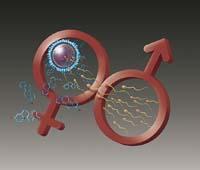Progesterone as the motor of sperm

Progesterone issued by the eggs is a great incentive for sperm, according to two independent German and American research groups in the journal Nature. It attracts the sperm to the egg and, when they interact with it, progesterone makes them move the tail faster, thus facilitating the passage of the thick superficial viscose layer of the egg.
Two groups of researchers have found that progesterone acts on the sperm in the calcium channel called CatSper. In fact, it causes the entry of calcium into the inside of the sperm, which makes the sperm hyperactive, that is, it makes them move the tail more strongly. Furthermore, scientists have discovered that men who have a mutation in the genes of the proteins that form the CatSper channel are sterile, since the sperm do not become hyperactive.
To reach these conclusions, researchers from the University of California (USA) measured the electric current within sperm in various situations. This is because the ion exchanges that occur on both sides of the cell membrane, such as calcium ions, affect this current. As they have seen that by adding progesterone increases the electrical current of the sperm. If CatSper channels are blocked, it does not occur. In addition, placed in high-pH environments - as the ovule environment usually is -, they indicate that CatSper channels are activated to a greater extent.
The team of German researchers, from the Centre for Advanced Studies and Research in Europe, measured the calcium concentration within sperm. These researchers found that the effect of progesterone is immediate and occurs faster than the usual molecular signaling of cells. Therefore, they concluded that CatSper channels have their own means to detect progesterone.
Buletina
Bidali zure helbide elektronikoa eta jaso asteroko buletina zure sarrera-ontzian











